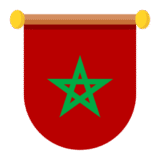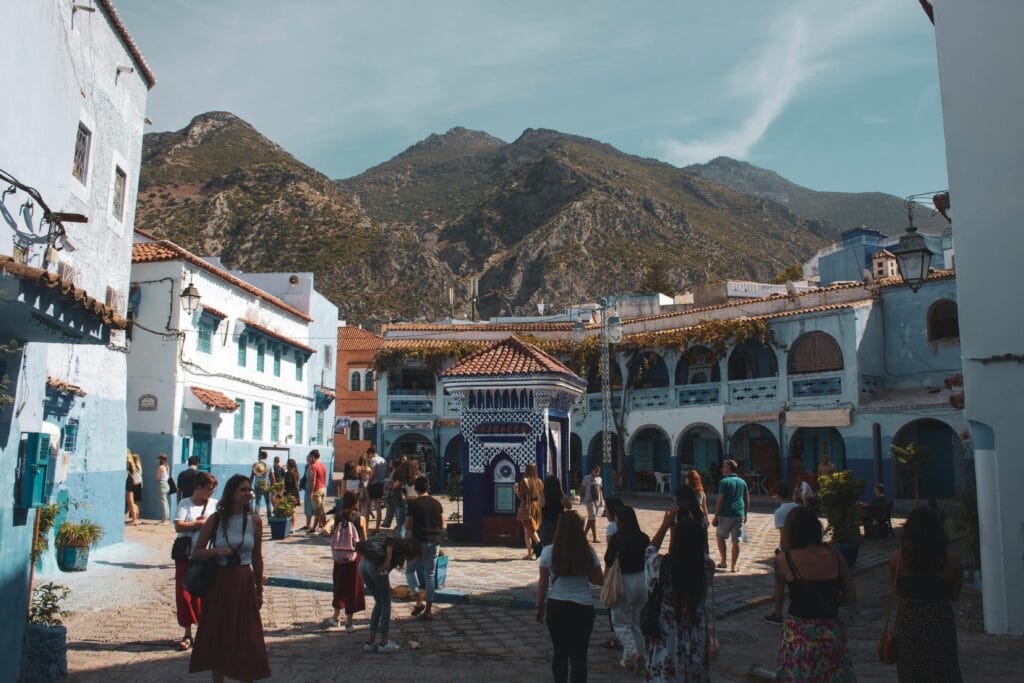Did you know Morocco’s winter temperatures can rival a mild California spring? Many travelers avoid North Africa in the cold months. But January is perfect for exploring Marrakech’s souks or trekking the snow-dusted High Atlas Mountains.
Morocco is a gem all year round, but its diverse climate requires careful planning. Coastal breezes cool Agadir’s beaches in summer, while Sahara nights can be freezing in winter. Late winter is great for quiet medinas and comfortable hiking.
January is special with unique cultural events. Locals celebrate Yennayer, the Amazigh New Year, with feasts and music. Imagine enjoying fragrant tagine while learning traditions under crisp skies.
Ready to plan your trip? Our free guide matches festivals, weather, and highlights to your style. Morocco’s magic awaits—you just need the right timing.
Weather and Climate Overview in Morocco
Imagine swapping coastal fog for desert sunshine in a day—Morocco makes it possible. Its climate changes like a kaleidoscope, blending Mediterranean freshness with Saharan extremes.
Understanding Morocco’s Diverse Climates
Northern cities like Chefchaouen have mild, rainy winters and dry summers. Marrakesh gets hot in summer, while the High Atlas Mountains are cold in January. Coastal Casablanca stays cool year-round.
Regional Temperature Insights and Trends
Your activities depend on where you are. Desert nights are cold in winter, while coastal markets are comfortable in spring. Trekking the Atlas peaks is better in April than July.
| Region | Summer High | Winter Low | Rainfall |
|---|---|---|---|
| Casablanca Coast | 75°F | 55°F | 16″ yearly |
| Marrakesh | 100°F | 40°F | 9″ yearly |
| High Atlas | 68°F | 20°F | 22″ yearly |
| Sahara Desert | 115°F | 28°F | 1″ yearly |
Rainfall patterns are important too. Chefchaouen gets 35″ annually, triple Marrakesh’s. Always check forecasts, as mountain passes might close in February.
Seasonal Guide: best time to visit morocco
Imagine hiking through cedar forests one week and sipping mint tea in a sunlit courtyard the next. Morocco’s seasons offer different adventures—your challenge is choosing the right one.
When Seasons Dictate Your Journey
Spring (March-May) is great for 70°F days and blooming trees. But hotel prices rise during Easter. Summer is hot, perfect for desert photos, but Marrakesh gets too hot by noon.
“Locals often advise swapping Sahara trips from July to October—your camel will thank you!”
—Ahmed, Berber Trekking Guide
Monthly Highlights Decoded
October’s 80°F afternoons are perfect for Fes’ medina without crowds. January offers crisp 50°F days for mountain views, though some lodges close. Always check forecasts—the coast stays mild when the desert shivers.
| Season | Best For | Avg Temp | Crowd Level |
|---|---|---|---|
| Spring | Hiking, festivals | 60–75°F | Moderate |
| Summer | Desert tours | 85–110°F | Low |
| Fall | City exploration | 70–90°F | High |
| Winter | Mountain retreats | 40–65°F | Low |
Pro tip: Use local expert itineraries (like those from Atlas Trekking Co) to dodge seasonal pitfalls. Whether you chase autumn’s Imilchil Marriage Festival or spring’s wildflower carpets, timing transforms your trip from good to unforgettable.
Exploring Morocco’s Diverse Regions and Landscapes
From golden dunes to misty cliffs, this country packs more scenery into one nation than some continents. Your journey could span Atlantic surf towns, silent desert expanses, and peaks where eagles circle snowfields—all within a week’s travel.
Where Land Shapes Adventure
Coastal areas like Essaouira charm visitors year-round with salty breezes and 70°F averages. Watch fishermen haul in sardines at sunrise, then wander blue-painted alleys where artisans craft thuya wood treasures. Unlike sweltering inland cities, the coast stays mild even in summer’s peak heat.
Venture south to the Sahara for starlit nights at desert camps. Winter brings crisp 60°F days perfect for camel treks, while summer’s 115°F temperatures test even seasoned travelers. Local guides recommend October-April for dune hikes and Berber cultural immersion.
The High Atlas Mountains deliver alpine thrills with a Moroccan twist. Spring thaw reveals wildflower trails near Imlil village, while December’s snow creates prime conditions for mountain refuge stays. Pack layers—weather shifts faster than a souk negotiation here.
- Essaouira: Windswept beaches meet fresh seafood feasts
- Merzouga Desert: Sunrise panoramas from Erg Chebbi dunes
- Toubkal National Park: North Africa’s highest peak awaits hikers
Whether you’re photographing almond blossoms in Tafraoute or sipping tea with nomads near Zagora, each region demands its own seasonal strategy. Match your travel dates to landscapes that sing in that month—your camera (and comfort) will thank you.
Cultural Events and Festivals
Morocco’s calendar bursts with celebrations that transform ordinary streets into living theaters. While planning your trip, aligning with these events offers rare glimpses into the country’s soul—from ancient harvest rituals to spiritual observances shaping daily life.
Celebrating Yennayer and Local Traditions
January’s Yennayer festival marks the Amazigh New Year with communal couscous feasts in villages like Imilchil. Families gather to share stories passed through generations, while dancers in vibrant attire perform to rhythmic ahidous music. These celebrations, rooted in agrarian traditions, let travelers experience Morocco’s pre-Islamic heritage firsthand.
Local guides often invite visitors to join olive harvests or bread-baking sessions during this period. As one Rif Mountain resident told us: “Sharing our meals bridges cultures—you taste history in every bite.”
Navigating Ramadan’s Impact on Your Travel Plans
During Ramadan, Marrakech slows down. Restaurants close until sunset, but hotels serve meals quietly. Public transport and attractions adjust their hours.
Dress modestly and avoid eating/drinking in public during the day. Evening brings iftar markets with sellou sweets and harira soup. Book desert tours early, as locals travel home before the holiday.
| Event | Locations | Travel Tip |
|---|---|---|
| Yennayer | High Atlas villages | Join a family meal via local guides |
| Ramadan | Major cities | Carry snacks; respect prayer times |
Essential Travel Tips and Packing Advice
When packing for Morocco, think layers and cultural awareness. The country’s climate varies from coastal breezes to desert heat. Your suitcase should be versatile for city walks and village visits.
Dress Code and Local Customs for a Respectful Visit
In Marrakech, wear light linen pants and tops that cover elbows. Coastal areas allow shorts, but rural areas prefer modesty. Carry a scarf for mosques or sudden cold.
Desert nights can be chilly, even in summer. Pack a fleece jacket with breathable cotton tees. For spring hikes, waterproof boots are better than sneakers.
| Region | Clothing Recommendations | Key Notes |
|---|---|---|
| Coastal Cities | Light layers, sun hats | Beachwear ok in resorts |
| Rural Villages | Long sleeves, ankle-length skirts | Avoid tank tops |
| High Atlas | Thermal base layers | Quick-dry fabrics ideal |
| Sahara Desert | Head wraps, closed-toe shoes | Sand-proof bags essential |
Showing respect opens doors. Guides suggest removing shoes before entering homes and using the right hand for greetings. A local proverb says: “The guest’s manners shape the host’s welcome.” Check [reliable travel resources] for updated etiquette tips.
Versatility is key. Convertible pants are shorts for the coast, and a pashmina is a blanket in the desert. Packing light lets you bring home treasures like rugs and pottery!
Highlights from Top Destinations in Morocco
Morocco’s cities are a mix of history and modern life. Each city offers unique experiences that stay with you. Let’s explore where to find these unforgettable moments.
Iconic Cities and Must-Visit Landmarks
Marrakesh’s Jemaa el-Fnaa square is alive with activity. It transforms into a food paradise at night. Spring is perfect for visiting the Bahia Palace, with its 75°F weather.
Casablanca’s Hassan II Mosque is awe-inspiring. Its minaret towers over the Atlantic, and the prayer hall’s cedar ceilings are stunning. Coastal breezes keep the summer heat manageable.
Don’t miss these standouts:
- Fes Medina: Explore the world’s largest car-free urban zone. Smell the tanneries and see ancient dyeing techniques.
- Essaouira: Enjoy the windswept ramparts for stunning sunset photos. Fresh seafood grills at the portside stalls.
- High Atlas Villages: Hike past walnut groves to waterfalls that roar in spring thaw.
Rabat is full of quiet elegance. The Hassan Tower’s unfinished columns feel like stepping back in time. Try Fes’ street-side bisara soup in cool March mornings.
Conclusion
Your Moroccan journey depends on the season. Coastal breezes cool markets in summer. Desert nights sparkle under winter stars.
Spring blooms paint mountain trails. Cultural festivals like Yennayer add color to colder months.
Regional weather offers unique chances. Marrakech is mild in October, while the Atlas peaks charm hikers in May. Always pack layers for sudden temperature changes.
This guide helps you plan your trip. Whether you want to avoid crowds or chase festivals, smart planning unlocks Morocco’s magic. Check our interactive guide for the latest on events and climate.
Ready to start your adventure? Morocco’s diverse landscapes and rich traditions await. Your perfectly timed escape begins now.
FAQ
When is the ideal season for exploring the Sahara Desert?
Late fall (October–November) or early spring (March–April) is best. These times have mild days and cool nights. Summer is hot, and winter nights can be cold.
How does Ramadan affect travel plans?
During Ramadan, many places close until sunset. Dress modestly and avoid eating/drinking in public. Expect quieter days but lively evenings. Dates change yearly based on the lunar calendar.
What clothing works best for mountain treks?
Wear lightweight, moisture-wicking layers for the High Atlas Mountains. Even in summer, evenings can be chilly. Bring sturdy hiking boots, a windbreaker, and sun protection for trails like Toubkal.
Are coastal cities like Essaouira worth visiting in winter?
Yes! Coastal areas stay mild (50s–60s°F) December–February. You’ll avoid crowds and enjoy fresh seafood. Just remember to pack a light jacket for breezy evenings.
Which festivals showcase local culture?
Don’t miss the Imilchil Marriage Festival (September) or the Gnaoua World Music Festival in Essaouira (June). Yennayer (Amazigh New Year) in January features traditional meals and celebrations in rural communities.
Can you visit Marrakech in July?
While possible, July is very hot (often 100°F+). Stay hydrated, book accommodations with pools, and explore souks early morning. Many locals escape to the Atlas Mountains or coast during peak summer.
What’s unique about spring in Morocco?
March–May brings blooming almond trees in valleys like Ourika. It’s comfortable for city sightseeing (70s°F). It’s the best time for photography, hiking, and avoiding winter chill and summer crowds.

